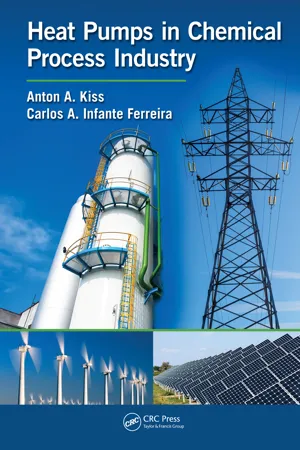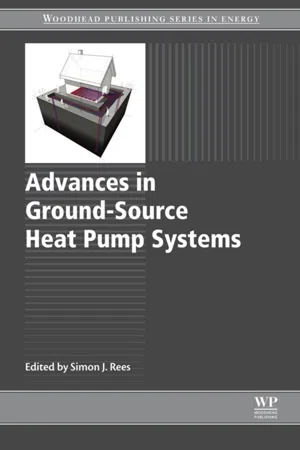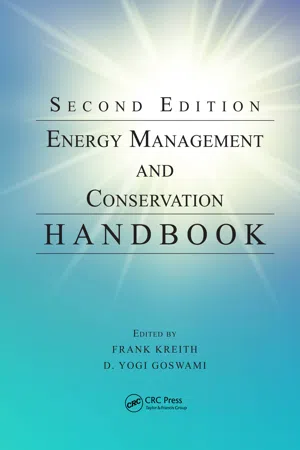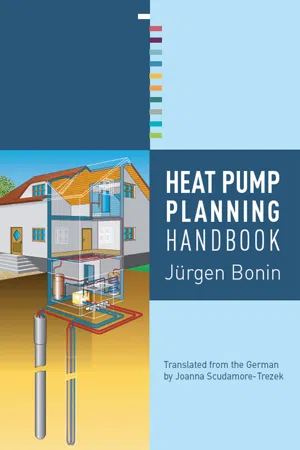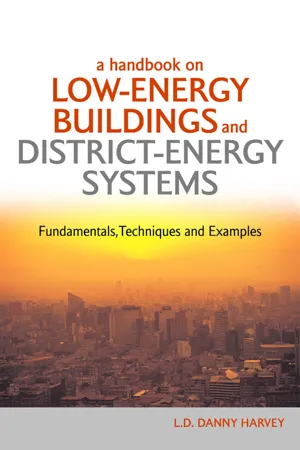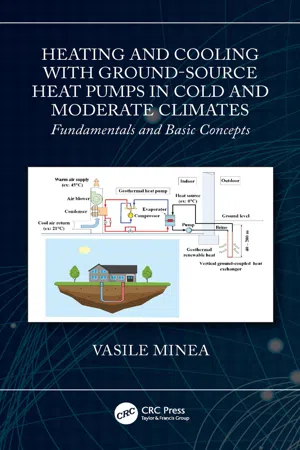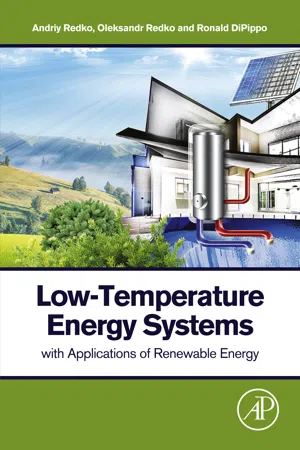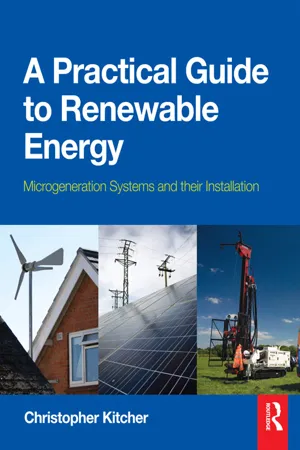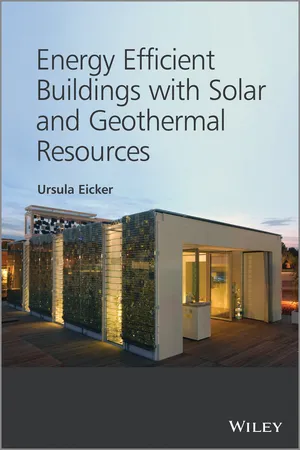Technology & Engineering
Heat Pump
A heat pump is a device that transfers heat from a lower temperature to a higher temperature using mechanical energy. It can be used for both heating and cooling purposes and is an energy-efficient alternative to traditional heating and cooling systems. Heat pumps are commonly used in residential and commercial buildings to provide comfortable indoor temperatures while reducing energy consumption.
Written by Perlego with AI-assistance
Related key terms
11 Key excerpts on "Heat Pump"
- eBook - ePub
- Anton A. Kiss, Carlos A. Infante Ferreira(Authors)
- 2016(Publication Date)
- CRC Press(Publisher)
CHAPTER 1 Introduction to Heat Pumps 1.1 INTRODUCTION A Heat Pump (HP) is a device that transfers energy from a heat source to a heat sink (destination) and upgrades the energy to a higher temperature level. Heat Pumps are designed to move heat in the opposite direction of normal heat flow by taking heat from a colder space and releasing it to a warmer one. Although the overall process seems to allow the heat to flow from the cold source to the warm destination, the normal heat flow from high to low temperature is respected in each step of the process. Note that a Heat Pump uses a certain amount of work (external power) to accomplish the transfer of energy from the heat source to the heat sink. The most common examples are refrigerators, air conditioners (ACs) and reversible-cycle Heat Pumps for providing thermal comfort. Notably, the term Heat Pump is more generic; it applies to many heating, ventilating and air conditioning (HVAC) devices used for space heating or cooling. When used for heating, a Heat Pump employs the same refrigeration-type cycle used by an air conditioner, but in the opposite direction – thus drawing heat from the ground or external air and releasing the heat into the air-conditioned space rather than the surrounding environment. Heat Pumps have several key advantages: very high efficiency as compared to gas-heated systems; the possibility to use environmental renewable energy from the air, water or ground; large energy savings of 50%–70% translated in reduced final and primary energy demand and significant reductions in greenhouse gas (GHG) emissions (e.g. CO 2). Nonetheless, Heat Pumps also have some drawbacks: An initial investment is needed (so payback times might be an issue), an electrical connection is required to be present typically and some refrigerants used in a Heat Pump are toxic or flammable (health, safety, environment [HSE] issues) - eBook - ePub
Audel HVAC Fundamentals, Volume 3
Air Conditioning, Heat Pumps and Distribution Systems
- James E. Brumbaugh(Author)
- 2011(Publication Date)
- Audel(Publisher)
Chapter 10 Heat Pumps A Heat Pump is a refrigeration device used to transfer heat from one room or space to another. The Heat Pump is designed to take heat from a medium-temperature source, such as outdoor air, and convert it to higher-temperature heat for distribution within a structure. By means of a specifically designed reversing valve, the Heat Pump can also extract heat from the indoor air and expel it outdoors. Because a Heat Pump system uses the reverse-cycle principle of operation, its operating principle is sometimes referred to as reverse-cycle conditioning or reverse-cycle refrigeration. The latter term is not correct because there are fundamental differences between the operating principles of a Heat Pump and a true refrigeration unit. The confusion probably stems from the fact that during the cooling cycle, the operation of a Heat Pump is identical to that of the mechanical refrigeration cycle in a packaged air-conditioning unit. The indoor coil functions as an evaporator, cooling the indoor air. The outdoor coil is a condenser, in which the hot refrigerant gas releases heat to the outside air. Heat Pump Operating Principles The two principal phases of Heat Pump operation are the heating and cooling cycles. A third phase, the defrost cycle, is used to protect the coils from excessive frost buildup. Heating Cycle The heating cycle of a Heat Pump begins with the circulation of a refrigerant through the outdoor coils (see Figure 10-1). Initially, the refrigerant is in a low-pressure, low-temperature liquid state, but it soon absorbs enough heat from the outdoor air to raise its temperature to the boiling point. Upon reaching the boiling point, the refrigerant changes into a hot vapor or gas. This gas is then compressed by the compressor and circulated under higher pressure and temperature through the indoor coils, where it comes into contact with the cooler room air that circulates around the coils - eBook - ePub
- Simon Rees(Author)
- 2016(Publication Date)
- Woodhead Publishing(Publisher)
1An introduction to ground-source Heat Pump technology
S.J. Rees University of Leeds, Leeds, United KingdomAbstract
Ground-source Heat Pumps (GSHPs, or geothermal Heat Pumps) have great appeal in offering levels of efficiency for building heat and cooling that are – both theoretically and practically – higher than other technologies. This chapter introduces the technology and reviews its historical development and current state of exploitation around the world. Current challenges and prospects are discussed.Keywords
Carbon emissions; Development; Ground-source Heat Pump technology; History; Outlook; Policy1.1. Introduction to the technology
1.1.1. Heat Pump principles
Heat Pumps are a form of heat engine that uses mechanical work to transfer heat from a low temperature source to a higher temperature sink. There are a wide range of applications of Heat Pumps but in this context we are concerned with transferring heat between buildings and the external environment – either rejecting heat to the environment and cooling the building or extracting heat and heating the building. Although various forms of thermodynamic cycle can be used to move heat between source and sink, the predominant form is based on the vapour–compression cycle in which a refrigerant gas is evaporated, compressed and condensed in turn to transfer heat. The principle components in the cycle are shown in Fig. 1.1 . The state of the refrigerant throughout the cycle is well illustrated in an enthalpy–pressure diagram such as that on the right of this figure. The enthalpy changes in the condenser and evaporator indicate the heat transfer rate per unit mass of refrigerant flowing. Chapter ‘New trends and developments in ground-source Heat Pumps - eBook - ePub
- Frank Kreith, D. Yogi Goswami, Frank Kreith, D. Yogi Goswami(Authors)
- 2016(Publication Date)
- CRC Press(Publisher)
9Heat Pumps
Herbert W. Stanford IIICONTENTS
9.1 Heat Pump Concept 9.2 Air-Source Heat Pumps 9.2.1 Premium Efficiency Air-Source Heat Pumps 9.2.2 Cold Climate Air-Source Heat Pumps 9.2.3 Dual Fuel Air-Source Heat Pumps 9.3 Water-Source Heat Pumps 9.3.1 Closed-Circuit Water-Source Heat Pump Systems 9.3.2 Closed-Circuit Geothermal Heat Pump Systems 9.3.3 Open-Circuit Geothermal Heat Pump Systems 9.3.4 Gas-Fired Engine-Driven Heat Pumps 9.3.5 Heat Recovery Chiller/Heat Pump System 9.3.6 Variable Refrigerant Flow Heat Pump System 9.4 Advanced-Technology Heat Pumps 9.4.1 Absorption Cycle Heat Pumps 9.4.2 Solar-Assisted Heat Pumps Bibliography9.1 Heat Pump Concept
Heat Pumps are reverse cycle building heating/cooling units or systems that can extract heat from a building and reject that heat to the environment, providing cooling for a building, and can switch from providing cooling to providing heating by extracting heat from the environment and rejecting that heat into a building . This heat transfer cycle can be accomplished using a vapor-compression refrigeration cycle or an absorption refrigeration cycle; though by far, vapor-compression systems are more widely used (see Section 9.4 for more discussion of absorption cycle systems).All refrigeration cycles hinge on one common physical characteristic: if a chemical compound (which we can call a refrigerant ) changes phase from a liquid to a gas, a process called evaporation , the compound must absorb heat to do so. Likewise, if refrigerant changes phase back from a gas to a liquid, the process of condensation , the absorbed heat must be rejected. Thus, all refrigeration cycles depend on circulating a refrigerant between a heat source (from which heat is removed, thus producing cooling) and heat sink - eBook - ePub
- Jürgen Bonin(Author)
- 2015(Publication Date)
- Routledge(Publisher)
3 What is a Heat Pump and how does it work?A Heat Pump is a ‘refrigerating machine’, a machine usually used for cooling (e.g. a refrigerator). It works by removing heat from an interior space through cooling. This extracted heat must subsequently be released elsewhere. In a refrigerator, this is achieved using a cooler (condenser), which emits the heat into the ambient air.Heat Pumps or refrigerating machines have a long history. The first safe and functional ammonia-refrigerating machine was built by Carl von Linde in 1876. This marked the start of the combined use of cold and heat.Figure 3.1 1876 – Carl von Linde built the first refrigerating machineFigure 3.2 The refrigerator – a Heat Pump refrigerating machine3.1 Why is a Heat Pump called a ‘Heat Pump’? The term ‘Heat Pump’ can be explained using the following diagram. A Heat Pump ‘pumps’ heat from a lower temperature level to a higher temperature level.Figure 3.3 shows a water-water Heat Pump: it extracts heat from groundwater with a temperature of 10 °C by cooling it to 7 °C. This extracted heat is used, for example, for heating water to a flow temperature of 35 °C. After being used for underfloor heating, for example, the heating water subsequently flows back to the Heat Pump at 5 °C lower (i.e. it is returned at 30 °C).Figure 3.3 Temperature levels in a Heat PumpThus the Heat Pump has pumped heat from 10 °C to 35 °C. The Heat Pump has to work in order to reach this temperature level. This requires energy, usually in the form of electricity drawn from the mains supply.When it comes to generating hot water, the Heat Pump needs to ‘pump’ the ‘heat’ to a higher temperature level, to a flow temperature of 55 °C. The Heat Pump has to work harder to reach this higher flow temperature, and this requires more electrical energy.That means:• The higher the required flow temperature, the harder a Heat Pump needs to work. Therefore, it is extremely important that the temperature difference between the heat source (e.g. groundwater, brine or air) and thermal heat (e.g. flow temperature for heating) is as small as possible. - eBook - ePub
A Handbook on Low-Energy Buildings and District-Energy Systems
Fundamentals, Techniques and Examples
- L.D. Danny Harvey(Author)
- 2012(Publication Date)
- Routledge(Publisher)
fiveHeat Pumps
Heat Pumps can be used for heating, air conditioning and the production of hot water. Residential air conditioners and commercial chillers operate on the same principles as Heat Pumps, so they can be thought of as Heat Pumps that operate in only one direction, to cool buildings. Indeed, in some parts of the world (such as Japan), the majority of air conditioners are reversible, so they are really Heat Pumps. In any case, much of the information presented in this chapter is applicable to air conditioners and commercial cooling equipment, and so forms a complement to Chapter 6 , where this equipment is discussed.5.1 Operating principles
The natural tendency of heat is to flow from warm to cold. A Heat Pump transfers heat against its natural tendency, from cold to warm, in the same way that a bicycle pump moves air against its natural tendency, from low pressure (outside the tyre) to high pressure (inside the tyre). In both cases, work must be done (requiring energy).There are two broad types of Heat Pumps, based on either a vapour compression cycle or an absorption cycle. A vapour compression Heat Pump can be powered by electricity or by mechanical shaft power. The latter is used in industry and sometimes in the central cooling plants of district cooling systems. An absorption Heat Pump uses heat rather than electricity or mechanical power as the energy input to drive the Heat Pump. Absorption chillers (used for cooling purposes only) are much more common than absorption Heat Pumps (used for cooling and heating). Electric vapour compression Heat Pumps are widely available and have been mass marketed for decades. Thus, this chapter focuses on electric vapour compression Heat Pumps, while absorption (and other) chillers are discussed in Chapter 6 .An outline of how an electric vapour compression Heat Pump works is found in Box 5.1. The transfer of heat from cold to warm is accomplished through a compression—expansion cycle involving a refrigerant or working fluid. If heat needs to be transferred from the outside to the inside of a building, the refrigerant must be cooled (through expansion) to a temperature colder than the outside, so that it can absorb heat from the outside. This absorption occurs through a heat exchanger —a coil through which the refrigerant flows as outside air is blown past it. As the refrigerant absorbs heat, it evaporates rather than increases in temperature, so the heat exchanger is called an evaporator. Once inside the building, the refrigerant must be warmed (by compressing it) to a temperature warmer than the medium to which the heat is transferred (either air or water), so that it will release heat to the inside. Once again, the heat transfer occurs through a heat exchanger, which maximizes the contact area between the warmed refrigerant and the air or water to be heated. As heat is released from the working fluid, the working fluid condenses rather than decreases in temperature, so this heat exchanger is called a condenser. The difference between the evaporator and condenser temperature is referred to as the temperature lift. - eBook - ePub
Heating and Cooling with Ground-Source Heat Pumps in Cold and Moderate Climates
Fundamentals and Basic Concepts
- Vasile Minea(Author)
- 2022(Publication Date)
- CRC Press(Publisher)
8 Geothermal Heat PumpsDOI: 10.1201/9781003032540-88.1 Introduction
In order to use very low temperatures of shallow ground/soil, groundwater, or surface water as heat sources for efficiently heating the buildings in cold and moderate climates, geothermal Heat Pumps are needed to increase their temperature levels (e.g., from 5°C to 10°C) to much higher levels (e.g., up to 35–45°C) by the addition of an external, generally, electrical work.The geothermal Heat Pumps are brine (water)-to-air, brine (water)-to-water, or refrigerant-to-refrigerant machines based on mechanical vapor compression reverse Rankine cycle designed to operate over extended ranges of heat source entering temperatures (e.g., as low as –5°C in the heating mode and as high as 35–40°C in the cooling mode) (ARI 1998 ).In cold and moderate climates, geothermal Heat Pumps are commonly available with nominal cooling capacities between 1.75 and 70 kW in a wide variety of configurations (e.g., compact or split, and vertical or horizontal), with or without desuperheaters (components used to preheat domestic/process hot water by recuperating heat from the compressor superheated discharge vapor).8.2 Thermodynamic Parameters
In thermodynamic systems, the heat and work that can lead to changes in the system internal energy, are equivalent variables. The specific (mass) heat (q , J / kg) is defined as the microscopic (internal) energy naturally in transit from a high-temperature body to a lower temperature object via a heating process. On the other hand, the specific (mass) work (w , J / kg) done by the unit mass (kg - Andriy Redko, Oleksandr Redko, Ronald DiPippo(Authors)
- 2019(Publication Date)
- Academic Press(Publisher)
In hospitals, various areas should be categorized according to their functions and then the corresponding temperature requirements should be specified. In order to facilitate operation, Heat Pumps should be designed and built with a power being sufficient for centralized heat supply with well-isolated heat networks. The Heat Pump can simultaneously cool water needed for air conditioning, and heat water needed for sanitary purposes in summer. A traditional boiler should be used as a peak source for winter heating. In some cases, due to the varying functionality of rooms and their occupancy with patients or visitors, local individual Heat Pumps should be used. With the introduction of lower night rates for electricity, it makes sense to use cold and heat storage units to cover peak loads and save money.3.3.1. Ventilation systems
Among the most effective facilities for the application of Heat Pump technologies are the ventilation systems of industrial, public and residential premises. Due to the small difference in temperatures of the inflow and exhaust air, it is possible to attain high energy efficiency using Heat Pumps in ventilation systems at moderate ambient temperatures. However, when the temperature of ambient air is lowered, the efficiency of simple Heat Pump ventilation circuits decreases significantly, which results in the use of more complex circuits. In this regard, excellent results are achievable with Heat Pump and recuperative ventilation systems, in which the final energy effect is determined by a combination of an exhaust air heat recovery unit and a Heat Pump.3.3.1.1. Ventilation with an exhaust air heat recovery unit
In order to have air at the required temperature supplied to a room, radiators (heaters) of different models are used to heat the inflow air in the simplest ventilation systems. They can be water (steam), gas, or electric depending on the source of heat. The decision concerning the use of a particular type of heater for a particular system is made based on specific conditions, possibilities, and economic expediency. Hot water or electric heating is preferred because they offer the opportunity to control the temperature of air more precisely. When exhaust air at the temperature in a room is simply discharged to the environment, the efficiency of such systems is very low. So, exhaust air heat recovery units are used in ventilation systems (Fig. 3.15- eBook - ePub
An Introduction to Thermogeology
Ground Source Heating and Cooling
- David Banks(Author)
- 2012(Publication Date)
- Wiley(Publisher)
But the natural temperature of the subsurface and groundwater in the United Kingdom (10–13°C) places limits on the use of passive heating and cooling. Even with ideally efficient heat exchangers in the building, we cannot use these techniques to heat a fluid or a space above c.13°C or cool it below 10°C. Although ‘high-temperature’ building cooling systems are available that operate on fluid flow temperatures of 12°C (and may thus be amenable to passive cooling), many conventional building cooling systems are based on a fluid flow temperature of 6–7°C and return temperature (after the system has absorbed heat from the building) of c. 12°C.How can we overcome these limitations? Answer: we pump heat from a lower temperature to a higher temperature using a device called a Heat Pump. But before we consider the Heat Pump, let us look at its opposite: the heat engine.4.1 Engines
One can define an engine as a device that converts potential energy to work (Boxes 1.1 and 4.1). To do work, we need a potential energy gradient. This may be a chemical energy gradient, a gravitational potential energy gradient, a head gradient or a temperature gradient. Let us take the example of head of water. If we have two reservoirs of water with a difference in head between them (Box 1.2), we can allow water to flow from a higher head to a lower head and perform work, perhaps by employing a water wheel or hydraulic ram. Similarly, if we have two heat reservoirs at different temperatures, we can perform mechanical work. The net effect is a flow of heat from the high-temperature source to a low-temperature exhaust.BOX 4.1 Kilowatts and Kilowatt-HoursA kilowatt is a unit of power: a rate of energy generation, transfer or consumption. One kilowatt (1 kW) is equal to 1000 joules per second (1000 J s−1 ).A kilowatt-hour (kWh) is a unit of energy. It is the amount of energy generated/consumed by an appliance rated at 1 kW left running for 1 h. In other words,Similarly,A steam engine is a heat engine: the high-temperature source is steam at a temperature in excess of 100°C, while the low-temperature exhaust is often a water condensate. Internal combustion engines are also heat engines: the source is a hot gas (from fuel combustion), from which the heat is degraded (while doing mechanical work) to a lower-temperature exhaust. Stirling engines (Box 4.2) are another type of heat engine, which can operate on very low temperature differentials.BOX 4.2 The Stirling EngineWe have already seen (Section 4.1) that a heat engine exploits the flow of heat from a high-temperature source to a low-temperature sink. It converts some of this heat to mechanical work. The most familiar forms of heat engine include the steam engine and the internal combustion engine, where the heat sources are steam and hot combustion gases, respectively. - eBook - ePub
- Christopher Kitcher(Author)
- 2012(Publication Date)
- Routledge(Publisher)
4 C H A P T E R Heat PumpsHeat Pumps are a very efficient method of heating water and there are two basic types. An air to water Heat Pump which takes the latent heat in the air and a ground source Heat Pump which takes the latent heat from the ground.Air to water Heat PumpThe basic principle of the operation is that residual heat is taken from the air, usually outside air, although sometimes it is taken from exhaust air such as that from commercial kitchens or air conditioning units. This air is passed through a heat exchanger (evaporator) which is made up sealed coils full of refrigerant which has a very low boiling point. The temperature of the outside air passing over the coils causes the refrigerant to evaporate, the vapour is then passed through a compressor which raises its temperature to a usable level.This is much the same as pumping up a bicycle tyre; when you compress the air in the bicycle pump, the pump gets quite hot because the air in the pump is being compressed and some of the heat from the air is absorbed by the pump body.When the vapour has been compressed and its temperature has increased it is passed through another heat exchanger (condenser) where the heat from the vapour is transferred into the water which is being used for heating purposes. As the heat is taken from the refrigerant the vapour cools and returns to liquid, although it is still under pressure. The refrigerant fluid is then allowed to pass through an expansion valve which allows the fluid to expand, which in turn reduces the temperature of the fluid. The cycle is now repeated (Fig.4.1 ).Air source Heat Pumps can deliver water at a temperature of up to 65°C, although this can depend on the temperature of the outside air. This temperature would be sufficient for domestic water applications although supplementary heating may be required if demand is high or the outside air temperature drops very low. When supplementary - Ursula Eicker(Author)
- 2014(Publication Date)
- Wiley(Publisher)
The term ‘Heat Pump’ describes only the machine itself. A decisive factor for efficiency and costs of a Heat Pump system is the temperature level of the environmental heat source, from which heat can be extracted, with efficiency rising with temperature level of the heat source.Heat Pumps or chillers can be characterised in accordance with DIN EN 14511, which specifies first the heat transfer medium for the outdoor heat exchanger and second, the heat transfer medium of the indoor heat exchanger.Heat transfer medium
Table 8.1 Classification according to DIN EN 14511 for the most common Heat Pumps or chiller systems.Outdoor heat exchanger Indoor heat exchanger Classification Air Air Air / Air Heat Pump or Air-cooled Air conditioner Water Air Water / Air Heat Pump or Water-cooled Air conditioner Brine Air Brine / Air Heat Pump or Brine-cooled Air conditioner Air Water Air/ Water Heat Pump or Air-cooled Chiller Water Water Water / Water Heat Pump or Water-cooled Chiller Brine Water Brine / Water -Heat Pump or Brine-cooled Chiller Heat sources for Heat Pumps
Instead of ambient air used in air to air or air to water Heat Pumps it is adivsable to use heat sources with higher temperature levels, as this improves the Heat Pump efficiency. Vice versa for cooling machine operation it is advisable to reject heat at a lower temperature level than hot ambient air in summer.Horizontal ground heat exchangers at low depth (below 2 m) allow to extract heat of about 10 - 35 W m−1 depending on the soil conductivity. Vertical heat exchangers with about 100 m depth allow a heat extraction between 20 and 70 W m−1
Index pages curate the most relevant extracts from our library of academic textbooks. They’ve been created using an in-house natural language model (NLM), each adding context and meaning to key research topics.
